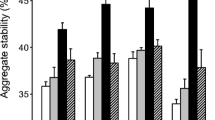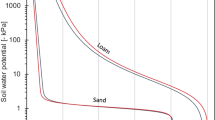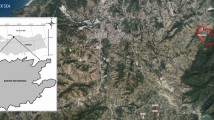Abstract
The influence of inoculation with arbuscular mycorrhizal fungi (AM fungi) on soil water characteristics of fast and slowly wetted vertisol samples was studied. Vertisols characteristically have a low stability to wetting, and the disruption of their larger pores when they swell leads to reduced water infiltration and thereby to runoff. The degree of aggregate breakdown determines the ability of the soil to drain. A vertisol was used in this pot experiment with four treatments: T1: Pasteurized soil, T3: Pasteurized soil, with plants, T4: Inoculated, pasteurized soil, with plants, T5: Unpasteurized soil, with plants. A treatment using inoculated, pasteurized soil (T2) was included in a related study (Bearden and Petersen, 2000) comparing aggregate stability, and the present study follows the same numbering to aid in comparison of experiments. After fast, disruptive wetting, the soil inoculated with AM fungi (T4) was found to have a lower soil water content than did the soils from the other treatments at matric potentials lower than −3.92 kPa. This indicates greater drainage from pores smaller than 75 μm for the soil inoculated with AM fungi, and the greater drainage appears to be directly related to a characteristic pore range between 67 and 75 μm. The soil without plants (T1), when wetted fast, had a lower soil water content at matric potentials higher than −3.92 kPa than soils from the other treatments, which indicates less pore volume due to pores larger than 75 μm in the treatment without plants. The pore indexes, calculated as the ratio between the slope of the fast and the slope of the slowly-wetted water characteristics, generally had the highest values for the soil inoculated with AM fungi (T4) from matric potential 0.00 to −0.29 kPa. In this matric potential range, the pore indexes were less than one. The unpasteurized soil with naturally present AM fungi (T5) generally had the highest pore indexes from matric potential −0.49 to −3.92 kPa, and the pore indexes in this matric potential range were above one. These results indicate the smallest loss of very large pores in the soil inoculated with AM fungi (T4) and the largest gain of smaller sized pores in the unpasteurized soil (T5). This suggests that the resistance to breakdown of the largest pores is related to the presence of roots, and that the gain of groups of smaller pores is related to the presence of hyphae.
Similar content being viewed by others
References
Bearden B N and Petersen L 2000 Influence of arbuscular mycorrhizal fungi on soil structure and aggregate stability of vertisols. Plant Soil 218, 173–183.
Childs E S 1940 The use of moisture characteristics in soil studies. Soil Sci. 50, 239–250.
Childs E S 1942 Stability of clay soils. Soil Sci. 53, 79–92.
Collis-George N and Figueroa B S 1984 The use of high energy moisture characteristic to assess soil stability. Short communication. Aust. J. Soil Res. 22, 349–356.
Collis-George N and Laryea K B 1971 Infiltration behaviour of structurally unstable soil under ponded and non-ponded conditions. Aust. J. Soil Res. 9, 7–20.
Coughlan K J 1984 The structure of vertisols. In The Properties and Utilization of Cracking Clay Soils. Eds. JW McGarity, EH Hoult and HB So. pp 87–96. Proceedings of a Symposium held in Armidale, August 1981, Reviews in Rural Science 5, University of New England, Armidale.
Degens B P, Sparling G P and Abbott L K 1996 Increasing the length of hyphae in a sandy soil increases the amount of water-stable aggregates. Appl. Soil Ecol. 3, 149–159.
Dexter A R 1988 Advances in characterization of soil structure. Soil Till. Res. 11, 199–238.
Elliott E T and Coleman D C 1988 Let the soil work for us. Ecol. Bull. 39, 23–32.
Gupta V V S R and Germida J J 1988 Distribution of microbial biomass and its activity in different soil aggregate size classes as affected by cultivation. Soil Biol. Biochem. 20, 777–786.
Harris R F, Chesters G and Allen O N 1966 Dynamics of soil aggregation. Adv. Agron. 18, 107–169.
Jastrow J D, Miller R M and Lussenlop J 1998 Contributions of interacting biological mechanisms to soil aggregate stabilization in restored prairie. Soil Bio. Biochem. In press.
Klute A 1986 Water retention: Laboratory methods. In Methods of Soil Analysis, Part 1. Ed. A. Klute. pp 635–662. American Society of Agronomy, Inc., Soil Science Society of America, Inc. Madison, Wisconsin.
Kilbertus G 1980 Études microhabitants contenus dans les agrégats du sol, leur relation avec la biomasse bacterienne et la taille des procaryotes presents. Rev. Ecol. Biol. Sol, 17, 543–557.
Miller R Mand Jastrow J D 1990 Hierarchy of roots and mycorrhizal fungal interactions with soil aggregation. Soil Biol. Biochem. 5, 579–584.
Miller R M and Jastrow J D 1992 The role of mycorrhizal fungi in soil conservation. In Mycorrhizae in Sustainable Agriculture. ASA Spec. Pub. 54. pp 29–45. Argron. Soc. Am., Crop. Sci. Soc. Am. and Soil Sci. Soc. Am., Madison, Wisconsin.
Perfect E, Kay B D, Van Loon W K P, Sheard R W and Pojasok T 1990 Rates of change in soil structural stability under forages and corn. Soil Sci. Soc. Am. J. 54, 179–186.
Reid J B and Goss M J 1980 Changes in aggregate stability of a sandy loam effected by growing roots of perennial ryegrass. J. Sci. Food Agric. 31, 325–328.
Reid J B and Goss M J 1981 Effect of living roots of different plant species on the aggregate stability of two arable soils. J. Soil Sci. 32, 521–541.
Reid J B, Goss M J and Robertson C W 1982 Relationship between the decreases in soil stability effected by the growth of maize roots and changes in organically bound iron and aluminium. J. Soil Sci. 33, 397–340.
SAS Institute Inc. 1985 SAS users guide: Statistics, version 5 Edition. SAS Institute, Cary, USA. 494 p.
Thomas R S, Dakessian S, Ames R N, Brown M S and Bethlenfalvay G J 1986 Aggregation in a silty loam soil by mycorrhizal onion roots. Soil Sci. Soc. Am. J. 50, 1494–1499.
Thomas R S, Franson R L and Bethlenfalvay G J 1993 Separation of vesicular-arbuscular mycorrhizal fungus and root effect on soil aggregation. Soil Sci. Soc. Am. J. 57, 77–81.
Tisdall J M and Oades J M 1979 Stabilization of soil aggregates by the root systems of ryegrass. Aust. J. Soil Res. 17, 429–441.
Tisdall J M and Oades J M 1980 The management of ryegrass to stabilize aggregates of a red-brown earth. Aust. J. Soil Res. 18, 415–422.
Tisdall J M and Oades J M 1982 Organic matter and water-stable aggregates in soils. J. Soil Sci. 33, 141–166.
Tisdall J M, Smith S E and Rengasamy P 1997 Aggregation of soil by fungal hyphae. Aust. J. Soil Res. 35, 55–60.
Wu L, Vomocil J A and Childs S W 1990 Pore size, particle size, aggregate size and water retention. Soil Sci. Soc. Am. J. 54, 952–956.
Author information
Authors and Affiliations
Rights and permissions
About this article
Cite this article
Neergaard Bearden, B. Influence of arbuscular mycorrhizal fungi on soil structure and soil water characteristics of vertisols. Plant and Soil 229, 245–258 (2001). https://doi.org/10.1023/A:1004835328943
Issue Date:
DOI: https://doi.org/10.1023/A:1004835328943




